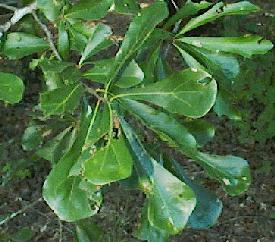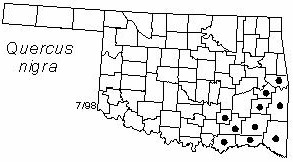

Tree to 25 m (80 ft) tall and 60 cm (24 in) diameter, with rounded crown. Bark dark gray, smoothish, becoming black and furrowed into ridges on lower trunk and older branches. Twigs slender, gray-brown, glabrous, ending in a cluster of small pointed dark red finely hairy buds. Leaves alternate, obovate or wedge-shaped, 4-13 cm (1.6-5 in) long and 2-5 cm (0.8-2 in) wide, broadest above the middle, unlobed to shallowly lobed (shade leaves and seedling leaves are often lobed while sun leaves on older trees tend to be unlobed), glabrous dark green above, with tufts of hairs in vein axils below, turning yellow in late fall or early winter. Fruits are acorns maturing in the second year, nearly round, 1-1.5 cm (0.4-0.6 in) diameter, with low saucer-shaped cup.
Distribution: Native to the coastal plain and piedmont of southeastern United States.
Habitat: bottomland forests, abandoned fields.
Comment: An important timber tree, marketed with several other species as "red oak". Quercus is the ancient classical name for the European oaks; nigra means "black" and probably refers to the bark.
NWI status: FAC +
Distribution in Oklahoma: 
BACK
NEXT
RETURN TO INDEX
Last update: 9/17/99
 Go to Oklahoma Biological Survey Home Page
Go to Oklahoma Biological Survey Home Page
 Disclaimer
Disclaimer